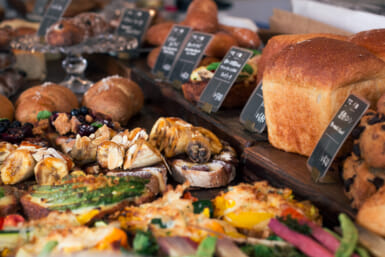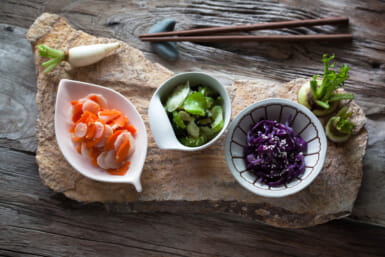For Garlic Lovers Only!
Garlic has been around, it would seem, forever, although its origins are unclear. Waverly Root, in his culinary encyclopedia “Food,” lists nine possible sources ranging from central Asia to southern Europe. Garlic was mentioned in the writing of the ancient Romans and Egyptians; the Greek historian Herodotus even tells us that the laborers who built the pyramids were given garlic to maintain their strength.
No matter how accurate or apocraphyl the history of garlic, in today’s world everyone agrees that garlic does have some health-promoting qualities. It is recognized as an aid to digestion and a factor in lowering blood pressure. Garlic tablets are even available at my local Tokyo supermarket— although why anyone would opt for a pill when he could have on plate of linguine with garlic sauce, I don’t know.
It was the famous French chef Marcel Boulestin who remarked, “It is not really an exaggeration to say that peace and happiness begin, geographically, where garlic is used in cooking.” So, get out the garlic and add some peace and happiness to your dining table.
First, a few tips on basic garlic preparation:
- It is important that garlic be fresh. When shopping, look for large, plump cloves and avoid garlic that has discolored or wrinkled skin — a sign that the garlic is old and its taste will be very strong and bitter.
- One easy way to peel garlic is to place the individual cloves on a cutting board and gently cut firmly press each clove with the flat side of a chef’s knife; this loosens the skin and it will peel off readily.
- Store garlic in a cool, dry place; do not refrigerate it.
- For just a hint of garlic flavor in stews, put one or two whole garlic cloves on a skewer and cook it along with the stew, removing before serving. This works well with soups and sauces, too.
- For a subtle garlic taste in salads, cut a garlic clove in half and nib it on the inside of the salad bowl. Another method is to rub the half clove of garlic on a piece of dry bread and put the bread with the salad greens and dressing in a bowl; toss lightly and discard the bread—the merest hint of garlic will remain.
- To chop or to press? There little agreement on this one. Some cookbooks such as “Joy of Cooking” and “The Frugal Gourmet” list a garlic press as an essential tool in any well-stocked kitchen. Craig Claiborne disagrees; for him a garlic press is the sign of a lazy cook and he claims that he can detect a metallic taste in garlic prepared this way— only chopped garlic is used in his kitchen. There is a middle-of-the-road course: garlic can be crushed using a mortar and pestle or in a bowl with a spoon. For large quantities of garlic, use a food processor. With these tips in hand, let’s move on to some garlic recipes. A good one to start with is garlic soup.
Garlic Soup (serves 6)
- 2 tablespoons olive oil
- 8 large cloves garlic, pressed or chopped
- 1/4 teaspoon cayenne pepper
- Slices of French bread, toasted
- Salt to taste
- 1/4 teaspoon dried thyme
- 2 tablespoons grated fresh Parmesan cheese
- Preheat the oven to 450°.
- Put the olive oil in a saucepan, and saute the garlic and pepper, stirring often, until the garlic is golden.
- Add 2 quarts of water, salt and thyme to the saucepan. Simmer for 30 minutes.
- Line the bottom of an oven-proof tureen with slices of toasted French bread.
- Pour the garlic bouillion, through a strainer, into the soup tureen. Sprinkle Parmesan cheese over the soup.
- Put the tureen into the oven for about 5 minutes until the cheese is melted. Serve immediately.
Linguine with Oil and Garlic (serves 6 as a main course, or 8 as a first course)
- 1 pound linguine (or any thin pasta)
- 3/4 cup olive oil
- 4 cloves garlic, pressed or chopped
- 2 anchovy fillets, mashed
- Freshly ground black pepper to taste
- 3 tablespoons finely chopped parsley
- Cook the linguine according to package directions. Be careful not to overcook the pasta; it should be al dente, cooked through but still firm.
- While the pasta is cooking, put the olive oil in a large pot and saute the garlic, stirring constantly, until the garlic is golden. Add the anchovy, black pepper and parsley and continue cooking for a few minutes until the parsley wilts.
- Drain the cooked pasta thoroughly and put it into the pot with the sauce. Cook for one more minute, stirring so that the sauce is evenly distributed.
- Put the pasta into a heated bowl and serve.
Garlic Shrimp (serves 4)
- 24 large shrimp
- 4 tablespoons olive oil
- 3 cloves garlic, pressed or chopped
- 2 tablespoons bread crumbs
- 2 tablespoons fresh parsley, chopped
- 2 tablespoons freshly grated Parmesan cheese
- Preheat the broiler.
- Clean and devein the shrimp.
- Put two tablespoons of olive oil in a skillet, and saute the garlic until it is golden.
- Add the shrimp and cook until they turn pink.
- Remove the shrimp to 4 individual ramekins. Top with bread crumbs, parsley and Parmesan cheese. Drizzle 1/2 tablespoon of olive oil on each ramekin, and run them under the broiler until the cheese melts.
Chimichurri (Argentinian Parsley Sauce) (makes 6 cups)
- 2 cups olive oil
- 1 cup red wine vinegar
- 2 cups chopped onion
- 6 cloves garlic, pressed or chopped
- 1 cup finely chopped parsley
- 2 tablespoons dried oregano
- 1 tablespoon cayenne pepper
- 2 tablespoons freshly ground black pepper
- Combine all the ingredients in a bowl and mix until well blended. Serve at room temperature with grilled steaks or sausages. Chimichurri can be used as a marinade, too.
Aioli (Garlic Mayonnaise) (yield 2 1/2 cups)
- 4-6 cloves garlic
- 1/2 teaspoon salt
- 3 egg yolks
- 2 tablespoons fresh lemon juice
- 2 cups olive oil
- Peel the garlic cloves and put them into a food processor fitted with the steel blade; chop until very fine.
- Add the salt and egg yolks and process until the mixture is smooth.
- Add the lemon juice and process again until it is thoroughly mixed.
- With the food processor turned on, slowly pour in the oil, a drop or two at a time. Be sure the oil is thoroughly incorporated into the mixture before adding any more. When all the oil has been added, refrigerate the mayonnaise immediately. Serve with fish, vegetables or salads.








